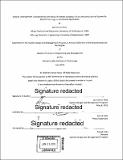System development considerations and point of interest guidance of an unmanned aerial system for remote sensing in commercial application
Author(s)
Roos, Jan Corver, S.M. Massachusetts Institute of Technology
DownloadFull printable version (10.55Mb)
Other Contributors
Massachusetts Institute of Technology. Engineering Systems Division.
Advisor
Patrick Hale.
Terms of use
Metadata
Show full item recordAbstract
The objective of this thesis is to develop a contextual and system level understanding of an ISR (Intelligence, Surveillance and Reconnaissance) Unmanned Aerial System (UAS) for commercial application. The thesis is intended to support strategic decision making for creating and capturing value in the emerging Unmanned Aerial Vehicle (UAV) industry and to support system design decisions. As an example of a system design decision, a flight control capability to enable directing the flight of a UAV through the steering of the optical payload only is also proposed and developed. This flight control capability is intended to more closely align the operation of an ISR unmanned aerial system with the identified primary user need. Thus, the development presented here could be useful to the prospective entrepreneur or an established organization who would like to build a presence in the emerging commercial application of unmanned aircraft. Towards these objectives, four aspects are considered: 1. To develop an understanding of the current state of the emerging commercial unmanned aircraft industry. 2. Understanding the current and potential future regulatory requirements associated with the commercial operation of unmanned aircraft. 3. To develop a system design understanding of an ISR unmanned aerial system which includes identifying the primary need, developing a stakeholder value network, identifying the principle elements of form and understanding the principle internal functions. 4. Propose and develop a flight control capability which enables directing the flight of a UAV through the steering of the optical payload only. This flight control capability serves as a system design example to more closely align the operation of an ISR unmanned aerial system with the identified primary user need.
Description
Thesis: S.M. in Engineering and Management, Massachusetts Institute of Technology, School of Engineering, System Design and Management Program, Engineering and Management Program, 2016. Cataloged from PDF version of thesis. Includes bibliographical references (pages 78-79).
Date issued
2016Department
Massachusetts Institute of Technology. Engineering and Management Program; System Design and Management Program.Publisher
Massachusetts Institute of Technology
Keywords
Engineering and Management Program., System Design and Management Program., Engineering Systems Division.